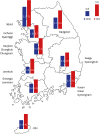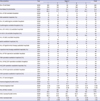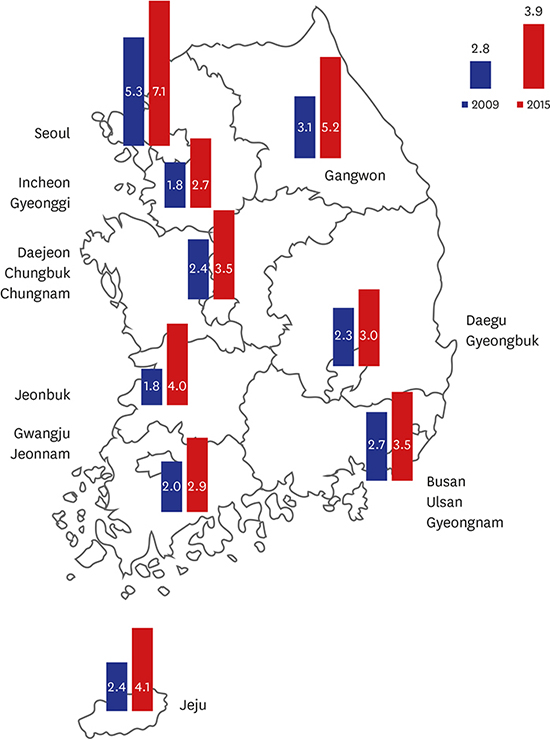ACKNOWLEDGEMENTS
We are grateful to the Medical Research Collaborating Center at Seoul National University Hospital for their support for statistical analyses. We thank Dr. Byung Il Kim, Dr. Chong-Woo Bae, Dr. Son Moon Shin, Dr. Jin A Lee, Dr. Ju Young Lee, Dr. Sae Yun Kim, Dr. Jun Hwan Song, Dr. Jae Hyun Park, Dr. Shin Yun Byun, Dr. Seung Hyun Lee, Dr. Eun Song Song, Dr. Yoon Joo Kim, and Mr Tae Yun Kim for their invaluable advices during the survey. We express our deep appreciation to the pediatricians of the institutions participated in this survey. These institutions were: Ajou University Hospital, Asan Medical Center, Boramae Medical Center, Bucheon Seoul Woman Hospital, Bucheon St. Mary's Hospital of The Catholic University of Korea, Bundang Cha Hospital, Busan St. Mary's Medical Center, Gachon University Gil Hospital, Cheil General Hospital & Women's Healthcare Center, Chonbuk National University Hospital, Chonnam National University Hwasun Hospital, Chonnam National University Hospital, Chosun University Hospital, Chung-Ang University Hospital, Chungbuk National University Hospital, Chungnam National University Hospital, Daegu Catholic University Medical Center, Daegu Fatima Hospital, Daejeon Eulji University Hospital, Daejeon St. Mary's Hospital, Dankook University Hospital, Dong-A University Medical Center, Dongguk University Ilsan Hospital, Dongtan Jeil Women's Hospital, Ewha Womans University Mokdong Hospital, Gangnam Cha Hospital, Gangneung Asan Hospital, Good Moonhwa Hospital, Gwangmyeong Sungae Hospital, Gyeongsang National University Hospital, Hallym University Dongtan Sacred Heart Hospital, Hallym University Kangdong Sacred Heart Hospital, Hallym University Kangnam Sacred Heart Hospital, Hallym University Sacred Heart Hospital, Hanyang University Guri Hospital, Hanyang University Hospital, Hyundai Hospital for Women's & Children's, Ilsin Christian Hospital, Incheon St. Mary's Hospital of The Catholic University of Korea, Inha University Hospital, Inje University Busan Paik Hospital, Inje University Haeundae Paik Hospital, Inje University Ilsan Paik Hospital, Inje University Sanggye Paik Hospital, Jeju National University Hospital, Kangbuk Samsung Hospital, Kangwon National University Hospital, Keimyung University Dongsan Medical Center, Konkuk University Medical Center, Konyang University Hospital, Korea University Anam Hospital, Korea University Ansan Hospital, Korea University Guro Hospital, Kosin University Gospel Hospital, Myongji Hospital, Kumi Cha Hospital, Kwangju Christian Hospital, Kyung Hee University Hospital, Kyung Hee University Hospital at Gangdong, Mizmedi Hospital, Kyungpook National University Chilgok Hospital, NHIC Ilsan Hospital, Presbyterian Medical Center, Pusan National University Hospital, Pusan National University Yangsan Hospital, Samsung Changwon Hospital, Samsung Medical Center, Sahmyook Medical Center, Seoul Eulji Hospital, Seoul Medical Center, Seoul National University Bundang Hospital, Seoul National University Children's Hospital, Seoul St. Mary's Hospital of The Catholic University of Korea, Soonchunhyang University Bucheon Hospital, Soonchunhyang University Cheonan Hospital, Soonchunhyang University Gumi Hospital, Soonchunhyang University Hospital, St. Vincent Hospital of The Catholic University of Korea, Sung-Ae General Hospital, Uijeongbu St. Mary's Hospital of The Catholic University of Korea, Ulsan University Hospital, Wonkwang University Hospital, Yeouido St. Mary's Hospital of The Catholic University of Korea, Yeungnam University Medical Center, Yonsei University Gangnam Severance Hospital, Yonsei University Severance Hospital, and Yonsei University Wonju Christian Hospital.









 PDF
PDF Citation
Citation Print
Print




 XML Download
XML Download